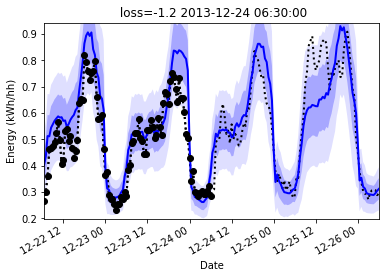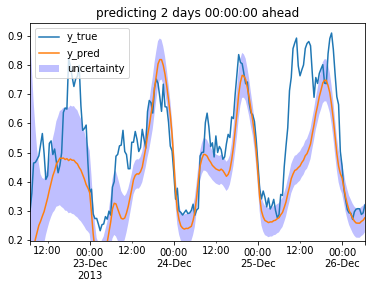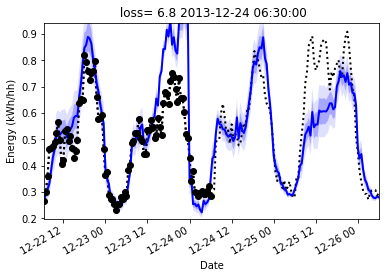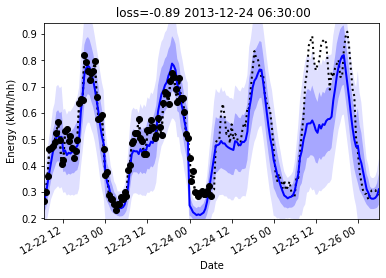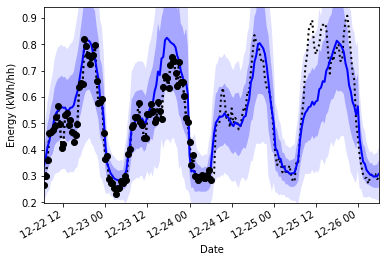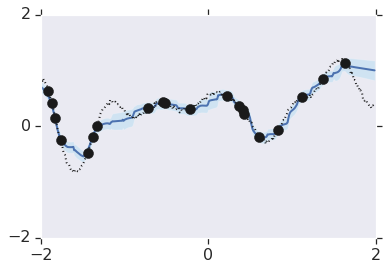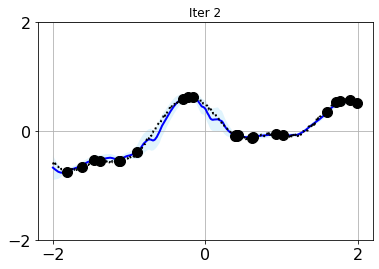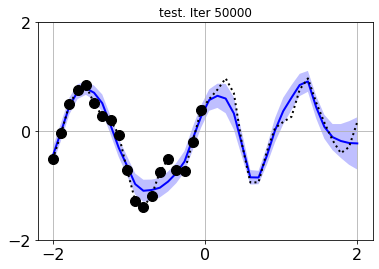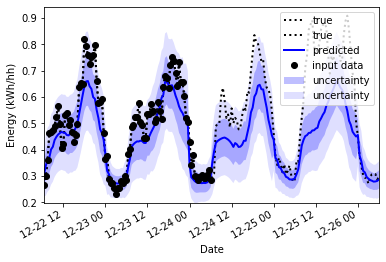3springs / Attentive Neural Processes
Projects that are alternatives of or similar to Attentive Neural Processes
Neural Processes for sequential data
This repo implements "Recurrent Attentive Neural Process for Sequential Data" (ANP-RNN) on a toy regression problem. And also tests it on real smart meter data.
This repository has lots of options so you can run it as a ANP-RNN, or ANP or NP.
- Models
- Experiments:
- Monte Carlo Dropout
- Data:
- Toy 1d regression
- Power prediction problem
I've also made lots of tweaks for flexibility and stability and replicated the DeepMind ANP results in pytorch. The replication qualitatively seems like a better match than the other pytorch versions of ANP (as of 2019-11-01). You can see other code repositories in the see also section.
It's not heavily documented, because most of my code never gets read or used. If you are using it, and it's confusing, make a github issue are we will add comments or docs together.
git clone
git-lfs pull
- Neural Processes for sequential data
- Citing
Experiment: Comparing models on real world data
Here I compare the models on smartmeter power demand data.
The black dots are input data, the dotted line is the true data. The blue line is the prediction, and the blue shadow is the uncertainty to one standard deviation.
I chose a difficult example below, it's a window in the test set that deviates from the previous pattern. Given 3 days inputs, it must predict the next day, and the next day has higher power usage than previously. The trained model manages to predict it based on the inputs.
Results
Results on Smartmeter prediction (lower is better)
| Model | val_np_loss | val_mse_loss |
|---|---|---|
| ANP-RNN(impr)(MCDropout) | -1.48 | |
| ANP-RNN_imp | -1.38 | .00423 |
| ANP-RNN | -1.27 | 0.0047 |
| ANP | -1.3 | 0.0072 |
| NP | -1.3 | 0.0040 |
| LSTM | -0.78 | 0.0074 |
Example LSTM baseline
Here is an LSTM with a similar setup: it has access to the y value in the context (first half). It's output is inferier and it's uncertainty estimation if poor. It starts of high since it hasn't had much data yet, but it should increase, or at least stay high in the second half as it moves away from it's data.
Example NP
Here we see underfitting, since the curve doesn't match the data
Example ANP outputs (sequential)
Here we see overfitting, but the uncertainty seems to small, and the fit could be improved
Example ANP-RNN outputs
This has a better calibrated uncertainty and a better fit
Example of ANP-RNN with MCDropout
Experiment: Comparing models on toy 1d regression
I put some work into replicating the behaviour shown in the original deepmind tensorflow notebook. At the same time I compared multiple models.
Results
Results on toy 1d regression (lower is better)
| model | val_loss |
|---|---|
| ANP-RNN(impr) | -1.3217 |
| ANP-RNN | -0.62 |
| ANP | -0.4228 |
| ANP(impr) | -0.3182 |
| NP | -1.2687 |
Example outputs
Compare deepmind:
And this repo with an ANP (anp_1d_regression.ipynb)
And a ANP-RNN
It's just a qualitative comparison but we see the same kind of overfitting with uncertainty being tight where lots of data points exist, and wide where they do not. However this repo seems to miss points occasionally.
Experiment: Using ANP-RNN + Monte Carlo Dropout
One more experiment is included:
The model tries to estimate the how unsure it is, but what about when it is out of sample? What about what it doesn't know that it doesn't know?
| Name | val_loss (n=100) [lower is better] |
|---|---|
| MCDropout | -1.31 |
| Normal | -1.04 |
We can estimate additional uncertainty by using Monte Carlo Dropout to see how uncertain the model acts in the presence of dropout. This doesn't capture all uncertainty, but I found that is does improve (decrease) the validation loss. The loss is calculated by the negative overlap of the output distribution and the target value so this improvement in the loss shows that MCDropout improved the estimation of the uncertainty.
Why didn't the model just learn to be more uncertain? Well I choose a challenging train, val/test split where the val data was in the future and showed quite differen't behaviour. That means that the validation data had behaviour the model has never seen before.
With MCDropout:
Without
For more details see the notebook ./smartmeters-ANP-RNN-mcdropout.ipynb
Usage
- clone this repository
- see requirements.txt for requirements and version
- Start and run the notebook smartmeters.ipynb
- To see a toy 1d regression problem, look at anp-rnn_1d_regression.ipynb
Smartmeter Data
- Some data is included, you can get more from https://www.kaggle.com/jeanmidev/smart-meters-in-london/version/11
- Inputs are:
- Weather
- Time features: time of day, day of week, month of year, etc
- Bank holidays
- Position in sequence: days since start of window
- Target is: mean power usage on block 0
Code
This is based on the code listed in the next section, with some changes. The most notable ones add stability, others are to make sure it can handle predicting into the future:
Changes for a sequential/predictive use case:
- target points are always in the future, context is in the past
- context and targets are still sampled randomly during training
Changes for stability:
- in eval mode, take mean of latent space, and mean of output isntead of sampling
- use log_variance where possible (there is a flag to try without this, and it seems to help)
- and add a minimum bound to std (in log domain) to avoid mode collapse (one path using log_var one not)
- use log_prob loss (not mseloss or BCELoss)
- use pytorch attention (which has dropout and is faster) instead of custom attention
- use_deterministic option, although it seems to do better with this off
- use batchnorm and dropout on channel dimensions
- check and skip nonfinite values because for extreme inputs we can still get nan's. Also gradient clipping
- use pytorch lightning for early stopping, hyperparam opt, and reduce learning rate on plateau
ANP-RNN diagram
Tips
- Make you normalise all data, ideally the output two, this seems to be very important
- Batchnorm, lvar, dropout: these seem ok but it's unclear to me how to make these help reliably. Attention dropout or lstm dropout can be especially unreliable.
- sometimes you need quite a large hidden space to model a process. Making the network deep seems to stop it learning effectivly. It would be helpfull to try differen't activations, initializations and make sure the gradient flows effectivly to deeper networks,
- The deterministic path had unclear value, I found it best to leave it out
- The absolute size and comparitive size of the context and target is important for performance.
- If the context is too long and complex the model cannot summarize it
- If the target is too long and complex the model cannot fit it well
- If the context is in the target, the model may collapse to just fitting this. To fix
- make it small
- or make the loss on this part downweighted, this seems like the best approach since x_context->y_context may still be a usefull secondary task
- or do not include context in target
- however including the target in the context may sometimes be helpfull
- This repo compares models, but the biggest difference in this situation would be from additional data sources, but that is outside the scope of these experiments
See also:
A list of projects I used as reference or modified to make this one:
- Original code in tensorflow from hyunjik11 (author of the original paper) : https://github.com/deepmind/neural-processes/blob/master/attentive_neural_process.ipynb
- First pytorch implementation by soobinseo: https://github.com/soobinseo/Attentive-Neural-Process/blob/master/network.py
- Second pytorch implementation KurochkinAlexey (has some bugs currently) https://github.com/KurochkinAlexey/Attentive-neural-processes/blob/master/anp_1d_regression.ipynb
- If you want to try vanilla neural processes: https://github.com/EmilienDupont/neural-processes/blob/master/example-1d.ipynb
I'm very grateful for all these authors for sharing their work. It was a pleasure to dive deep into these models compare the different implementations.
Neural process papers:
- 2019-12-12, "Probing Uncertainty Estimates of Neural Processes"
- 2019-10-17, "Recurrent Attentive Neural Process for Sequential Data" - LSTM on X before encoder, no code
- 2019-10-29, "Convolutional Conditional Neural Processes". code
- 2019-10-01, "Wasserstein Neural Processes" would be helpfull if the output dist never converges for your problem
- 2019-08-08, "Spatiotemporal Modeling using Recurrent Neural Processes" (infilling spatial information, using a RNN for time information, no code)
- 2019-06-13, "Recurrent Neural Processes" (2d and 3d over time, using LSTM in encoder/decoder, no code)
- 2019-06-19, "The Functional Neural Processes"
- 2018-12-03, "Empirical Evaluation of Neural Process Objectives"
- 2019-01-17, "Attentive Neural Processes" (using attention to prevent underfitting) code
- 2018-07-04, "Conditional Neural Processes" code
- 2019-06-24, "Sequential Neural Processes" code modelling a 1 or 2d process evolving over time
- 2018-07-04, "Neural Processes"
Blogposts:
Citing
If you like our work and end up using this code for your reseach give us a shout-out by citing or acknowledging

